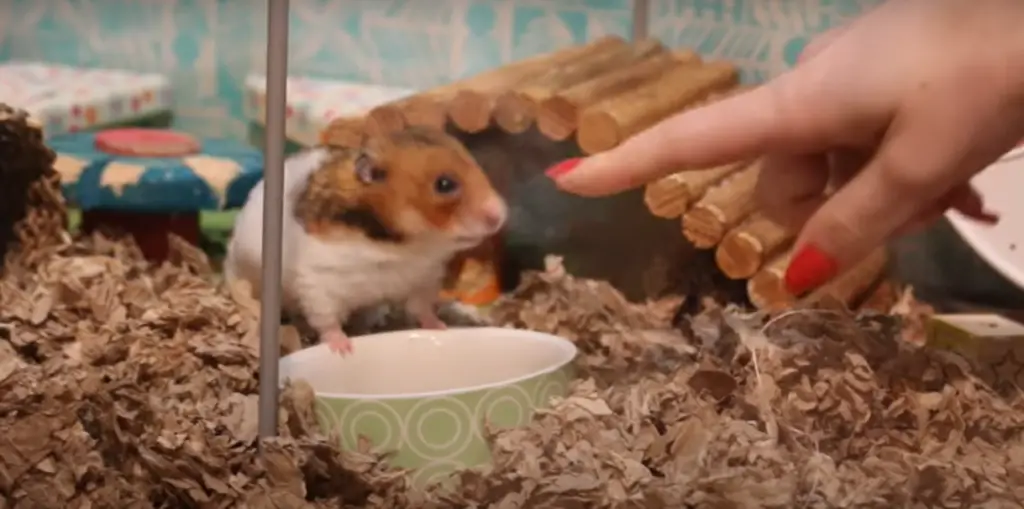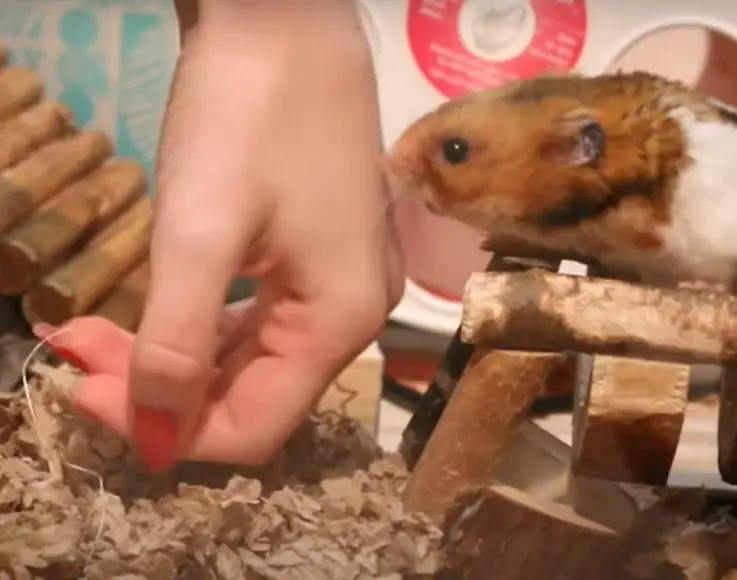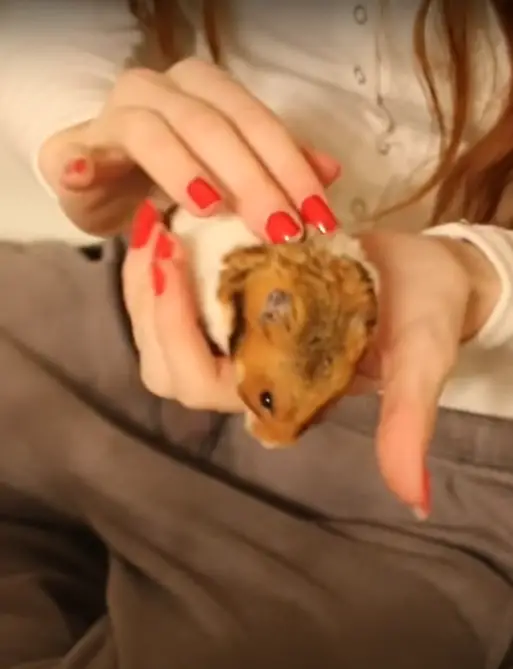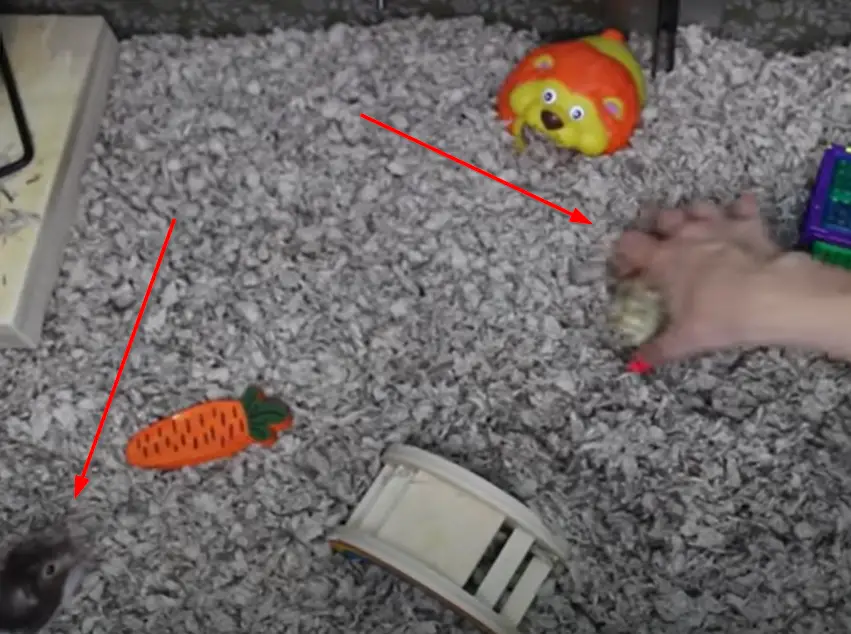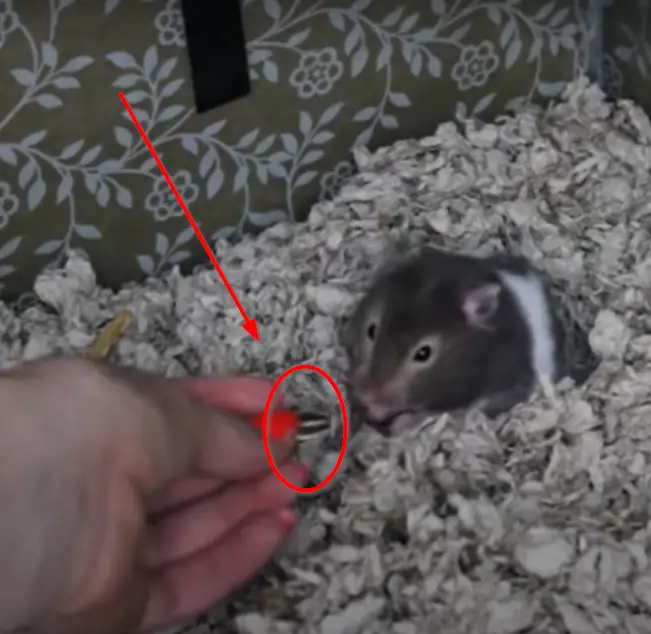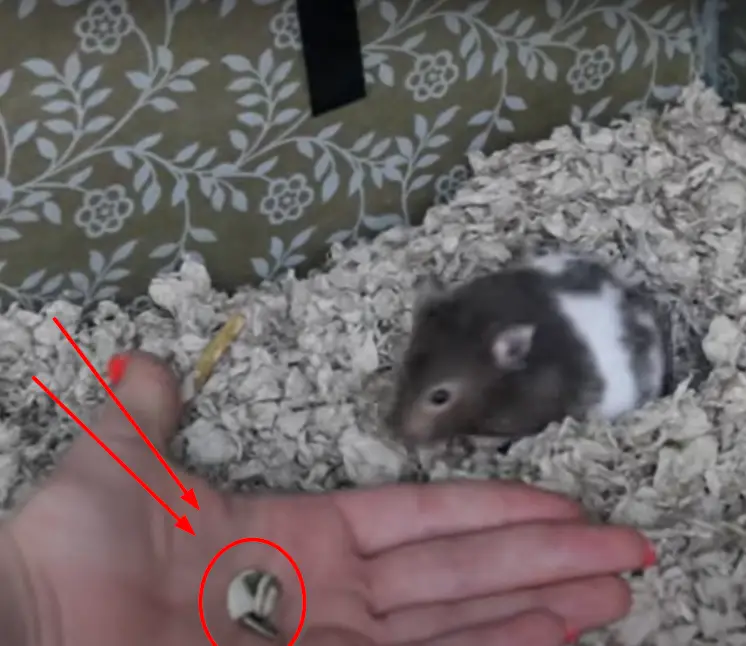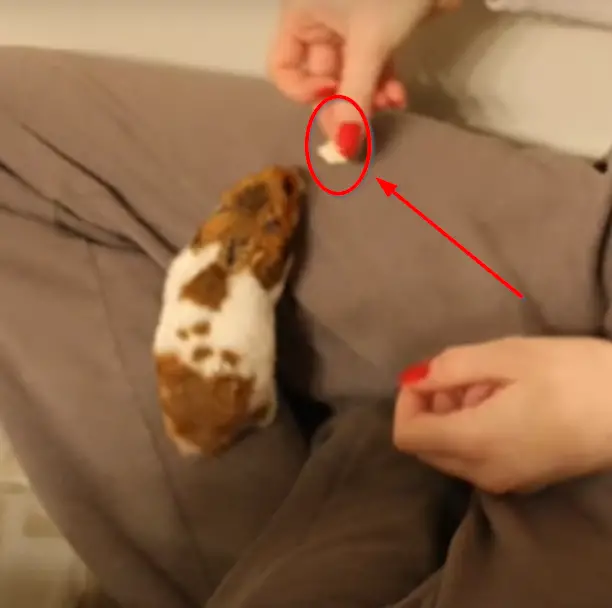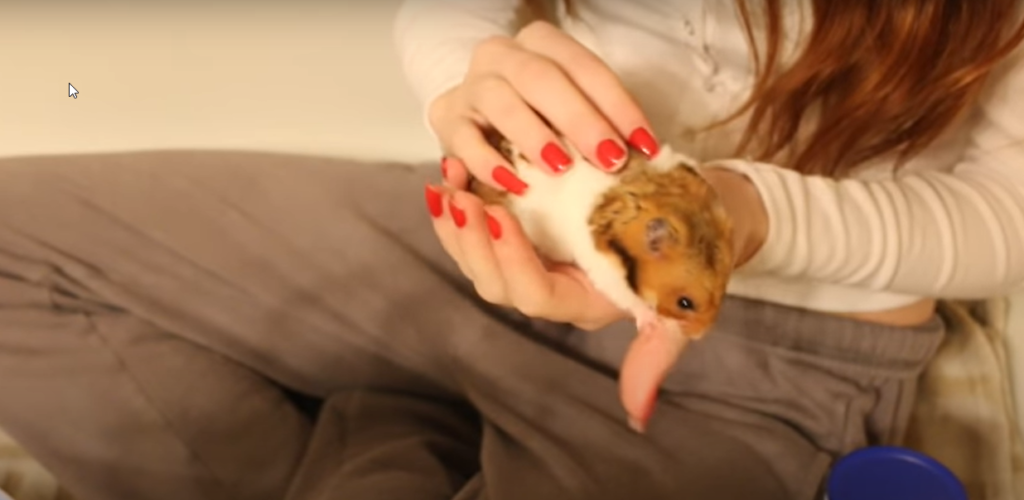Do Hamsters Bites ?
No, a hand-tamed hamster almost never intentionally bites unless you really hurt or scare him . Those that do bite are young, untamed hamsters or hamsters that have been stressed out by being introduced to their territory, a cage that is too small or another cage mate.
Why do hamsters bite?
There could be several reasons why a hamster will bite you or its cage mate, another hamster, and these are listed below:
When Hamsters bite their parents (in the hand):
1-The first reason why the hamster bites is that it has no other way to defend itself since it is stuck in the hand it is going to bite or the small cage in which the bitten hand was introduced unexpectedly.
2-The most common reason for hamsters to bite is when they are not yet tame and are not yet used to being held and handled.
3- A hamster will bite you if you put your hand in a burrow that it has dug in its litter box or nest where it sleeps.
4-The hamster will surely defend itself and bite you if you wake it up suddenly and especially in broad daylight.
5-The hamster may bite you if you put your finger in its food bowl (seeds) while it is eating.
6-Hamsters will bite if you hold them in your hand and squeeze them too hard!
7-A hamster will turn around and bite you when you surprise him and take him from behind!!! because he will think you are a predator before he recognizes you.
When hamsters bite their fellow hamsters “cage mates”:
As soon as hamsters reach the age of 4 weeks, they become sexually mature and the war for territory begins.
They will bite and fight each other for territory, food and females because they are solitary and territorial animals that need a lot of living space.
The females also bite when she’s pregnant or already had pups to protect.
Hamsters Accidental Bites
Not all hamster bites are intentional. These adorable creatures are not serial biters!
So it could be that your hamster accidentally bites you, even if it is tame and used to being held and handled by you.
In fact, it often happens that hamsters bite hands that smell of food, that’s why you must wash your hands before grabbing your hamster.
Remove all food odors and especially those of other hamsters if you have another one or even the smell of your cat or dog.
Another accidental bite could occur if you try to separate two hamsters that are fighting for territory or a female!
Your hamster may also accidentally bite you when you hand it a tiny piece of fruit, so I suggest that you skewer the small pieces of fruit or dried meat on the end of a toothpick before handing it to your hamster.
The bite of hamsters, preceded by a small cry of fear! are also accidental because you should never surprise a hamster from behind while it eats or drinks its water, and especially when it sleeps.
Bare Biting ( chewing ) and hamster bites related to its living conditions
Hamsters are not aggressive by nature. They are very loving and calm animals.
But you only need to lock them in a cage that is too small to create a monster that will bite any hand that opens the door of the cage , you will create a ” cage territorial hamster “.
Hamsters need a lot of floor space, at least 1000 square inches, and when you put them in a tiny cage, they will defend their territory by biting because it’s just their living space that you are attacking by inserting your hand.
It’s the same when you put two hamsters in the same cage, especially if the cage is not wide enough! 2000 inches square.
Your hamster will also bite your hand if you introduce yourself in its cage if it does not have hideouts, or corner of folds, never corner a hamster in a corner of the cage!
How to avoid being bitten by your hamster ?
1- First of all, you must buy your hamster from a breeder who is passionate and who will surely have tamed the hamster beforehand.
Hamsters born in pet shops and hamster mills are more aggressive by nature than those born in a breeder’s home, whose mother is already well tamed.
Baby hamsters will quickly learn that humans are not a threat.
Their character will be more docile and their taming will be easier, that’s why I recommend you to buy hamsters from professional breeders who are passionate about these little balls of hair.
2- Choose a purebred hamster and not a crossbred, because hybrids are often more aggressive, especially if they are born in a “Pets Mill” or a pet shop.
3- Buy a tame hamster if you doubt that you can do it yourself, you will find excellent tame hamster in “animal rescue shelters”.
4-Leave your hamster alone for two days after its arrival in your home and its new cage, give it time to learn its peers and detect its hideouts…etc
5-Never surprise a hamster who eats or wake up a hamster who sleeps! it is the assured bite.
6-If you reach out to your hamster and he backs away, leave him and try again a few moments later.
7- Never corner your hamster and then try to grab it!
8- Never let a child handle a hamster alone, always supervise this act in order to show the child the good gestures to adopt so as not to push the hamster to react to a bad handling by biting your child.
9-Tame your hamster, give him time to get used to you and his new environment ” you will find how to tame your hamster at the bottom of this article
Is there a breed of hamsters that bites more than the others?
Syrian hamsters, are the ones that bite the least, especially once hand-tamed and are installed in a large cage …
Then come the winter white hamsters, they are the calmest among the Dwarf hamsters.
Roborovski hamsters, are the most reckless and are more likely to use their teeth to defend themselves.
Finally, for a first hamster, I advise you not to buy a Campbell Dwarf Russian hamster, also nicknamed “Pitbull hamster” because of its unpredictable reactions when you try to handle it and take it!
Who bites more often, female or male hamsters?
When conditions are ideal, male hamsters are more docile than females, males are more easily picked up and handled than females, especially when they are in heat.
I am not saying that female hamsters are aggressive, but I find that males are more courageous and willing to interact with humans, to be taken.
It is also easier to scare a female hamster than a male, so you are not going to risk getting bitten accidentally when it is a male hamster.
Is the bite of a hamster painful or dangerous?
The sensation is more like being electrocuted!
At the beginning, you won’t feel anything !! but after 3 seconds, you will surely be tempted to throw it on the ground : ” never that ! Hold on to it or squeeze it! “
You won’t believe that your hamster will be able to open its mouth like that!
I wouldn’t call it pain, but it is a very bad experience to be bitten by a hamster.
Its teeth are very sharp and they can easily reach the bone of your finger, especially if it is a Syrian hamster bite.
Can my hamster transmit diseases if it bites me?
Unfortunately yes, hamsters (especially wild ones) can transmit its diseases to humans by biting them, such as lymphocytic choriomeningitis, a viral pathology that can be transmitted to humans by breathing or by biting.
On the other hand, the bites of hamsters do not involve any risk of transmission of rabies, it will be necessary before he contacts it himself (via your dog can be!)
What to do when your hamster bites your finger?
What you should never do when your hamster bites you is to never drop your hamster on the ground or squeeze it or make any sudden movement that could hurt it.
Before taking your hamster, even if it is tame, calm … etc., tell yourself often that it could bite you at any time! and if it happens, do not react! Physically !
What you have to do is to show your hamster that he hurt you by “emitting a little cry of pain”, it’s their language! This will make your hamster understand that he must not bite you.
So give a little cry each time your hamster bites you.
Then put him gently in his cage.
Then go and disinfect your hand and wash it well before coming back to your hamster, you should never punish your hamster for having bitten you.
The bite of a hamster is never by malice … it is either to defend itself, or by prevention or curiosity, yes hamsters bite to know what it is!
How do I know if my New hamster is already tame and won’t bite me?
A hamster can be calm without being tamed, it will remain calm as long as you do not invade its personal space.
But calm does not mean tame. Your hamster can have a calm personality and an easy character but it is enough to approach your hand so that it runs away or bites you !
Similarly, an energetic hamster will not become calm once tamed, it will just tolerate that you take it in your hands and caress it … etc
To sum up, a tamed hamster is a hamster that you will teach to trust and not fear you anymore .
You can buy a hamster already tamed, but for him you are a stranger, and you will have to redo all the work of taming even if in this case it will be less difficult than if the hamster has never been tamed before.
Moreover a tamed hamster may not like to be held and may bite at any time! It may just tolerate it, everything will depend on the character of the animal.
How to tame your hamster step by step :
How to stop this biting behavior?
You will have to be very patient and try to gain your hamster’s trust and make him understand each day a little more that you are his friend and that you are neither a threat, nor a competitor and especially not a predator.
This process of taming can extend over a few weeks if your hamster is of a fearful temperament and was born in a pet shop from a mother who is not very tame.
So follow these steps and be very very patient with these little balls of hair, here are the steps to follow to tame your hamster:
PS:
The duration of each step depends only on your talent, the temperament and the character of the hamster.
If you know that you will react badly and release your hamster if it bites you during this taming, I advise you to use natural leather gloves for example.
With these gloves, you will not get the bite of your hamster if you make a wrong gesture that will trigger this bite.
Step 1 ( 2 to 7 days ) Getting your hamster used to you :
Once your hamster is installed in his cage, give him at least 48 hours to get used to his new environment:
- To his new environment
- The new smells
- The elements of his cage
- Find and choose its shelters of folding
- Find its marks and appropriate the place (become owner)
- Getting used to the sounds of the house, your voice …
During this stage which will help a lot in the taming process thereafter, be also the only one in your family to approach him gently at dusk when he shows up
Sit near his cage, you can talk to him and above all do not touch the cage and do not make any sudden movement and never shout.
You must give him his food before he shows up, do this during the day.
Be aware that hamsters have a bad sight and at the slightest sudden movement or big noise, you risk to frighten him and this will ask you more time…
Your hamster should not see your other pets until it is well tamed (at least 2 months)
During this period, never touch it with your hands! Instead, use a small cardboard box or a large glass to guide your hamster inside if you need to take him out to clean the cage for example or to take him to the vet.
TIP: To get your hamster used to your smell faster, just take a cloth or a piece of toilet paper, and after you have washed your hands well, roll this paper in your hands so that it becomes impregnated with your smell and put this paper or this cloth that smells like you, in the cage of your hamster.
Step 2 (until the hamster comes to you!)
Once your hamster is accustomed to your presence and no longer flees when he sees you near his cage, you will move on to the next step which is to introduce your hand into his cage.
During this step, you will get your hamster used to the presence of your hand in his cage:
- Change your hamster’s water and give him his food when he wakes up late at night.
- Change a little of his wet litter, take gently an element and put it in its place, as a hideout, a toy, a rod already chewed,…
- Arrange his sandbox…
This way, your hamster will get used to your hand and will not see it as a threat. Don’t move it if your hamster decides to come and smell or inspect your hand during this stage.
Just let him sniff your hand, open it and don’t make any sudden movements even if he decides to bite you!
Step 3 eating from your hand :
Once your hamster is accustomed to the presence of your hand, prepare healthy treats, small pieces of carrots or sunflower seeds.
During this stage of your hamster’s taming process, you’ll want to do everything you can to get your hamster to accept the treat when you hold it in your hand.
- Be patient and use several treats until you find the one he will accept from your hand.
- Repeat the process.
- Don’t move your fingers if your hamster decides to stay and eat the treat near your hand.
- If he puts the treat in his cheek, give him another one or two.
Step 4 : Getting your hamster on your hand :
Once your hamster has become accustomed to accepting the treats you give him, you will move on to the next step.
During this stage of taming your hamster so that he doesn’t bite you anymore, you will try to get him to take the treat even if you place it in the palm of your hand, laying open in his cage.
He will then be forced to put his front paws on your palm so he can reach the treat.
Repeat this exercise until he finds it safe and normal to climb into your palm and take the treat.
Do not make any movement at first as your hamster climbs into your hand to retrieve the treat.
Step 5 (trying to pet your hamster inside the cage):
During this step, you will try to pet your hamster for the first time.
It is very important that you wash your hands well (just with water) especially during this period to remove any reasons why your hamster might bite you like the smell of food or another animal…
During this period, there are those who advise the Bathtub Bonding, you will put a blanket in the bathtub and the pillow to sit on.
You will actually get your hamster out of its cage (use a small container, a Cup …).
Put a treat in it and when your hamster comes in to retrieve it you gently carry it to the shower sink.
Make yourself comfortable in your shower tub and you will start by putting your hamster on your legs gently.
The Blanket is there to cushion the shock if your hamster decides to jump off your hand.
Sit in the sink and release your hamster onto the blanket.
You can place some treats on the blanket and let your hamster sniff around and discover this new environment.
On the first day, you can be satisfied with this achievement, which is to make your hamster discover this new place.
Your hamster may even be curious and climb on your lap by himself.
You will then try to get your hamster to climb on your lap using treats of course.
Then repeat the exercise of having your hamster eat from the palm of your hand and as it climbs onto your hand try to gently pick it up and bring your hand over your lap.
When you try to pick him up after he has grabbed the treat, you can use both hands without surrounding him, this is just to secure him.
If he decides to jump on the blanket, that’s okay; let him and once he’s calm, repeat this exercise.
During this step you can try to :
- Take your hamster in your hands
- Move it from one hand to another
- Stroke him on his back while he is in your hand
- Stroke him when you release him on the blanket
My 4 tips for this step:
- No sudden movements even if you get bitten
- Patience is your only ally during this exercise
- Watch your hamster’s reaction and choose carefully the moment when you will try to grab him in your hands and take him.
- Let your hamster come to you instead of running after it and forcing it to climb into your hands (use the natural curiosity of hamsters).
Final step:
Once your hamster is used to your hands and your caresses, you can finally take him directly in his cage, without using a Cup or a container and he will never bite you !!
Tame him in his cage and play with him …etc
You can finally enjoy your hamster to the fullest and he can also enjoy your caresses …..
Do hamsters bite to show affection?
Unlike rabbits and guinea pigs who may bite to show their affection and enjoy spending time with you, hamsters never bite to show affection, the reason is either to defend themselves, by accident or just by curiosity.
If your hamster wants to show you affection, it will simply avoid biting you even if you make the wrong gestures and you should be content with that.
A happy hamster is also a hamster that eats, drinks and especially that goes back and forth in its cage and plays in its wheel and sandbox, a dynamic hamster.
Do hamsters bite when they are hungry ?
Nope !! ; your hamster must be really hungry to bite you for that.
A hungry hamster :
- Will go back and forth to his food bowl.
- Spend more time than usual to search for food in his bedding , nest and litter… everywhere !!
- Will spend more time chewing on his chew toys and rods
- Will eat hay even though it is almost worthless to him.
- Will spend less time on his wheel
- Will be less energetic but will be quickly interested in you when you enter the room.
- Will come quickly to your hand to inspect it as soon as you put it in its cage.
- In extreme cases, a hungry hamster will do everything to escape from its cage.
Final thoughts about hamsters biting behavior
- Hamsters never bite out of spite but either :
- To defend themselves
- By accident
- By curiosity
When your hamster bites you, do not react and especially do not punish it because it is normal that a hamster defends itself!
Be patient and if you do not want to be bitten, adopt a goldfish !

